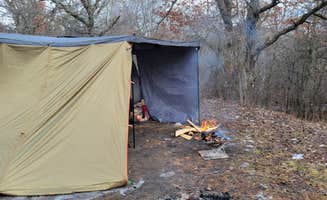South of Sand Dunes State Forest provides dispersed camping near Hanover, Minnesota in a mixed pine and hardwood ecosystem approximately 45 miles northwest of Minneapolis. The forest spans roughly 5,000 acres and sits on sandy soil formed from glacial deposits, creating a unique landscape that supports diverse wildlife. Winter temperatures can drop below -20°F, while summer camping season typically runs May through October with highs averaging 75-85°F.
What to do
Wildlife observation: The forest hosts diverse bird species including sandhill cranes and wild turkeys. One camper noted, "Quiet with lots of different bird sounds," while warning to "Stay away from [sandhill] storks. They attack" when protecting territory.
Hammock camping: The mixed pine stands create ideal hammock spots. According to a visitor, "I was able to walk in and find an incredible spot to camp and lay in my hammock" - perfect for reading or afternoon naps.
Vehicle exploration: County roads 233-237 provide routes through the forest, though vehicle restrictions apply on many side paths. As one camper explains, "A lot of the side roads are closed to motor vehicles due to some issues they had a couple years ago but are now taken care of like people dumping."
What campers like
Peace and quiet: After peak traffic hours, the forest becomes notably tranquil. One visitor reported, "After 12 p.m., not much of anything. I really recommend this for an easy stop if you're looking for a place to put up. It's peaceful and tons of spots to park."
Proximity to Twin Cities: The forest's location makes it ideal for quick getaways. A camper appreciated that "it's so close to home" allowing for spontaneous overnight trips without extensive planning or travel.
Easy access: The main forest roads remain accessible to standard vehicles. According to a reviewer, "I just did an overnight camp one night in a truck camper and it was very easy to navigate and it was cleaned quiet area to spend the night."
What you should know
Vehicle traffic concerns: Despite the remote setting, some forest roads experience surprising traffic volume. One camper warned, "This road is pretty busy for a dirt forest road and people FLY down it. Almost got hit a few times walking. Even through a Wednesday night cars are flying down the road."
Regulatory confusion: Law enforcement interpretations of camping rules may vary from DNR guidelines. A visitor shared this experience: "I had a county sheriff person tell me it's not lawful to park a trailer and they kicked me out. I called the dnr and they said that wasn't right but I decided to leave anyway."
Limited site sizes: Most camping areas accommodate smaller setups. A camper advised the spots are "Best for straight vehicles or very small trailers" due to space constraints and overhanging branches.
Insect preparation: Mosquitoes can be problematic, particularly at dawn and dusk. One visitor shared, "As to be expected, mozzies were present, but after 5mins of the door being opened and several flying in, we decided the area wasn't for us."
Tips for camping with families
Site selection strategy: Arrive early for better options. "Drove past several sites, most of which were by water. We did find one we thought we liked, but branches over hung, and rested on our camper (8ft high) and in fact most sites were shaded."
Pet considerations: Dogs enjoy the forest setting, though wildlife encounters require vigilance. One camper observed, "Saw lots of dogs, and mine had a blast, even had what seemed to be a stray husky quickly roll through camp around dusk. Something to keep on your mind."
Safety planning: Due to limited cell coverage, prepare for offline navigation and emergencies. Campers report that "phone signal is scarce" throughout most of the forest area.
Tips from RVers
Size restrictions: Larger rigs face significant limitations. Reviewers note there are "limited spots that are big-rig friendly" and most areas work best with smaller campers.
Overhead clearance: Tree canopies may restrict taller vehicles. One RVer mentioned branches "rested on our camper (8ft high)" which can scratch roof surfaces or damage equipment.
Pull-through availability: At least one dedicated pull-through area exists among the dispersed sites. According to a visitor: "One pull through area that I found" which can simplify parking for those with trailers.


